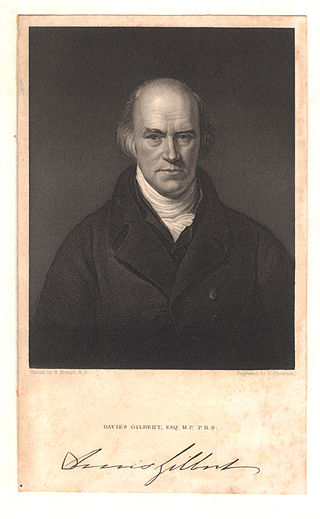
Falmouth is a town, civil parish and port on the River Fal on the south coast of Cornwall, England, United Kingdom. It has a total resident population of 21,797.

Penryn is a civil parish and town in west Cornwall, England, United Kingdom. It is on the Penryn River about 1 mile (1.6 km) northwest of Falmouth. The population was 7,166 in the 2001 census and had been reduced to 6,812 in the 2011 census, a drop of more than 300 people across the ten-year time gap. There are two electoral wards covering Penryn: 'Penryn East and Mylor' and 'Penryn West'. The total population of both wards in the 2011 census was 9,790.

Davies Gilbert was a British engineer, author, and politician. He was elected to the Royal Society on 17 November 1791 and served as President of the Royal Society from 1827 to 1830. He changed his name to Gilbert in 1817.
Sheriffs and high sheriffs of Cornwall: a chronological list:
The Davies-Gilbert family developed the towns of Eastbourne and East Dean in Sussex in the 19th century. They also owned the Estate of Trelissick, Truro (Cornwall) from 1844 until it was sold in 1913. There is some disagreement whether they are related to the Gilberts of Compton, Devon however, family research carried out in the late 18th century did not reveal a definitive link. There has been no research carried out since then. The earliest traceable member of the family is Thomas Gilbert . The family has the motto:

St Gluvias is a settlement in Cornwall, England, United Kingdom. The village is now a suburb on the northern edge of Penryn which is two miles (3.2 km) northwest of Falmouth. Until 1 April 2021 there was civil parish was called St Gluvias which doesn't include the suburb but it was renamed to Ponsanooth.

Mary Ann Gilbert was an English agronomist.

The Williams family of Caerhays, Burncoose and Scorrier were owners of mines and smelting works for several generations during the Cornish Industrial Revolution. A branch of the family settled in Port Hope, Ontario.
John Hearle Tremayne was a member of a landed family in the English county of Cornwall, and owner of the Heligan estate near Mevagissey. He was a member of the UK Parliament for the constituency of Cornwall, a Justice of the peace, and High Sheriff of Cornwall in 1831. He was also the second of four successive members of the Tremayne family who are credited with the creation of the gardens around Heligan House that are now well known as the Lost Gardens of Heligan.

Menabilly is a historic estate on the south coast of Cornwall, England, situated within the parish of Tywardreath on the Gribben peninsula about 2 miles (3.2 km) west of Fowey.
Mary Wolverston, Lady Killigrew, was a gentlewoman from Suffolk, married into an ancient Cornish family, who was accused of piracy during the reign of Queen Elizabeth I (1558-1603).
Thomas Tonkin (1678–1742) was a Cornish landowner and historian.

Alexander Pendarves, MP was a Cornish landowner and Tory politician who sat in the House of Commons between 1689 and 1725.

Members of the Basset family were amongst the early Norman settlers in the Kingdom of England. It is currently one of the few ancient Norman families who has survived through the centuries in the paternal line. They originated at Montreuil-au-Houlme in the Duchy of Normandy.
John Samuel Enys was a British mining engineer and scientist who wrote several important papers on the "duty" of steam engines and other types of power delivery, from water wheels to horses. He also made numerous studies on the extensive mining industry in Cornwall. On the death of his great uncle, Francis Enys in 1821 he inherited the Enys Estate, near Penryn, Cornwall and was appointed High Sheriff of Cornwall in 1824.
Samuel Enys was an English merchant and politician who sat in the House of Commons in 1660.
John Davies Enys was a New Zealand runholder and naturalist. He was born in Penryn, Cornwall, England to John Samuel Enys and Catherine and was educated at Harrow School. In 1861 he went to New Zealand with John Acland and sent flowering plants, shrubs and trees to Cornwall, for the gardens at Enys House.

Sir Thomas Grenville II, K.B.,, lord of the manors of Stowe in Kilkhampton, Cornwall and Bideford, Devon, Sheriff of Cornwall in 1481 and 1486. During the Wars of the Roses, he was a Lancastrian supporter who had taken part in the conspiracy against Richard III, organised by the Duke of Buckingham. On the accession of King Henry VII (1485–1509) to the throne, Sir Thomas was appointed one of the Esquires of the Body to Henry VII. On 14 November 1501 upon the marriage of Prince Arthur to Katherine of Aragon, he was created a Knight of the Bath. He served on the Commission of the Peace for Devon from 1510 to his death in circa 1513.

John Jope Rogers was the owner of Penrose, a house and estate near the Cornish town of Helston. The estate included Loe Pool, the largest lake in Cornwall, now owned by the National Trust. He was also an author and Conservative MP for Helston, Cornwall from 1859 to 1865.











